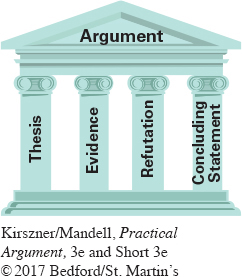Davis, Competitive Cheerleaders Are Athletes
EXERCISE 6.4
The following student essay, which includes all the elements of a Toulmin argument, was written in response to the question, “Are cheerleaders athletes?” After you read the essay, answer the questions that follow, consulting the outline on the previous page if necessary.
COMPETITIVE CHEERLEADERS ARE ATHLETES
JEN DAVIS
1
Claim and qualifier
Recently, the call to make competitive cheerleading an official college sport and to recognize cheerleaders as athletes has gotten stronger. Critics of this proposal maintain that cheerleading is simply entertainment that occurs on the sidelines of real sporting events. According to them, although cheerleading may show strength and skill, it is not a competitive activity. This view of cheerleading, however, misses the point. Because competitive cheerleading pits teams against each other in physically and technically demanding athletic contests, it should be recognized as a sport. For this reason, those who participate in the sport of competitive cheerleading should be considered athletes.
2
Warrant
Backing
Grounds
Acknowledging cheerleaders as athletes gives them the respect and support they deserve. Many people associate cheerleading with pom-
Page 204
3
Backing
Grounds
Recent proposals to rename competitive cheerleading “stunt” or “team acrobatics and tumbling” are an effort to reshape people’s ideas about what cheerleaders actually do. Although some cheerleading squads have kept to their original purpose—
4
Rebuttal
Qualifiers
Those in authority, however, are slow to realize that cheerleading is a sport. In 2010, a federal judge declared that competitive cheerleading was “too underdeveloped and disorganized” to qualify as a legitimate varsity sport under Title IX (Tigay). This ruling was shortsighted. Before competitive cheerleading can develop as a sport, it needs to be acknowledged as a sport. Without their schools’ financial support, cheerleading teams cannot recruit, offer scholarships, or host competitions. To address this situation, several national groups are asking the National Collegiate Athletic Association (NCAA) to designate competitive cheerleading as an “emerging sport.” By doing this, the NCAA would show its support and help competitive cheerleading to develop and eventually to flourish. This does not mean, however, that all cheerleaders are athletes or that all cheerleading is a sport. In addition, the NCAA does have reason to be cautious when it comes to redefining competitive cheerleading. Some schools have taken sideline cheerleading teams and recategorized them just so they could comply with Title IX. These efforts to sidestep the purpose of the law are, as one expert puts it, “obviously transparent and unethical” (Tigay). Even so, fear of possible abuse should not keep the NCAA from doing what is right and giving legitimate athletes the respect and support they deserve.
Page 205
5
Concluding statement
Competitive cheerleaders are athletes in every sense of the word. They are aggressive, highly skilled, physically fit competitors. For this reason, they deserve to be acknowledged as athletes under Title IX and supported by their schools and by the NCAA. Biased and outdated ideas about what is (and what is not) a sport should not keep competitive cheerleading from being recognized as the sport it is. As one proponent puts it, “Adding flexibility to the definition of college athletes is a common sense move that everyone can cheer for” (“Bona Fide”). It is time to give competitive cheerleaders the support and recognition they deserve.
Works Cited
“Bona Fide Athletes.” USA Today, 16 Oct. 2009, www.usatoday.com/story/opinion/2019/10/16/bona-
Sandler, Bernice R. “Certain Types of Competition Define Sports.” USA Today, 22 Oct. 2009, usatoday30.usatoday.com/
Thomas, Katie. “Born on the Sideline, Cheering Clamors to Be a Sport.” New York Times, 22 May 2011, www.nytimes.com/
Tigay, Chanan. “Is Cheerleading a Sport Protected by Title IX?” CQ Researcher, 25 Mar. 2011, p. 276. library.cqpress.com/
Identifying the Elements of a Toulmin Argument

Summarize the position this essay takes as a three-
part argument that includes the claim, the grounds, and the warrant. Do you think the writer includes enough backing for her claim? What other supporting evidence could she have included?
Find the qualifier in the essay. How does it limit the argument? How else could the writer have qualified the argument?
Do you think the writer addresses enough objections to her claim? What other arguments could she have addressed?
Based on your reading of this essay, what advantages do you think Toulmin logic offers to writers? What disadvantages does it present?